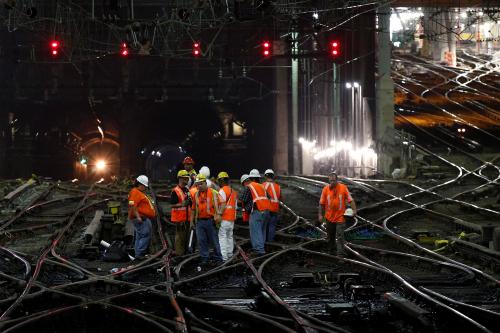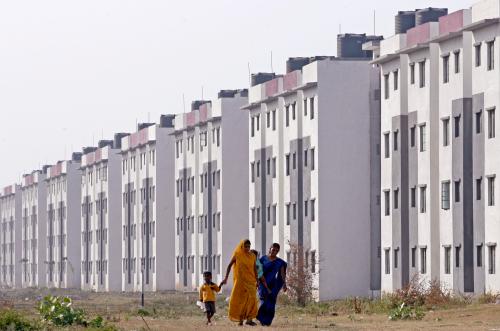This January, the Trump administration published a proposed rule to update long-standing government-wide regulations implementing the National Environmental Policy Act (NEPA)—the law which requires public disclosure and discussion of environmental impacts before undertaking a so-called “federal action.” All types of infrastructure—from roads and bridges to dams to conventional and renewable energy developments on public lands—are subject to NEPA, as are certain federal regulations.
From a transportation perspective, the administration is proposing some concerning changes that could weaken the core value of completing NEPA analyses.
While improving the efficiency of project reviews—and, in turn, the delivery of new infrastructure—is an important goal that the last three presidential administrations have all pursued, this proposed rule creates dangerous risks by limiting required analysis of key environmental impacts such as the air pollution generated over the lifecycle of an asset. Moreover, given the vast range of projects subject to NEPA—which in transportation can be anything from a small-town road to a section of interstate to a new rail line—the one-size-fits-all measures included in the proposed rule would incentivize inefficient workarounds.
From its inception, NEPA filled an important void within the context of transportation policy. It became law in 1970, against a backdrop of rapid urban and environmental changes. While highways carried the promise of connecting communities to interstate commerce and economic assets, they also changed the landscape by bifurcating urban cores and acquiring right-of-way disproportionately from lower-income communities. Even at a time best exemplified by Jane Jacobs and Robert Moses sparring over whether to build highways through downtown New York City, there was no structured way to ensure conversation with citizens about how a road, bridge, or railway would affect their neighborhood, and to give them an opportunity to articulate their views or concerns.
Transportation infrastructure can grow the economy and connect people’s lives, but it can also carry costs—to the natural landscape, to the fabric of a neighborhood, or to the quality of the air that we breathe. For half a century, NEPA has provided a vital framework for assessing those tradeoffs. The law’s original mission—to recognize “the profound impact of man’s activity on the interrelations of all components of the natural environment”—remains salient.
Unfortunately, the Trump administration’s proposed rule threatens to compromise the spirit and intent of NEPA by undermining several of its core elements.
First, this rulemaking seeks to lead states away from considering the indirect and cumulative effects of federal actions. In a transportation context, these terms involve studying impacts such as vehicle emissions resulting from use of a newly built or expanded road, or added traffic to a span of roadway adjacent to the project itself. Today, we have the tools and the scientific knowledge to understand the lifetime impacts of our decisions, including air pollution. With transportation now the leading source of greenhouse gas emissions nationwide, these impacts are of growing importance when we consider strategies to improve air quality and fight climate change.
Moreover, looking holistically at impacts can actually add efficiency to the NEPA process when documentation incorporates compliance with other important environmental laws, including the Clean Air Act, the Clean Water Act, and historic preservation statutes. This avoids a scatter plot of uncoordinated processes that would likely take longer, in aggregate, if done separately.
Second, this proposal weakens opportunities for public involvement. Transportation assets move people and goods, so it is critical to ensure that prospective projects solve for the needs of the traveling public—whether it’s connecting residential communities with retail and educational institutions or linking freight routes with market destinations. Identifying stakeholders with equities early in the lifecycle of a project is important for assessing needs as well as for identifying potential concerns that must be resolved in order to avoid conflict and delay during construction. NEPA should structure this type of engagement.
While the goal of shortening review timelines is laudable, the short deadlines and page limits that this rule proposes would likely push critical analysis work outside the NEPA framework. This means that initial work to define the scope and footprint of a project would precede formal public input opportunities that are designed to allow stakeholders to engage in those very discussions.
Finally, the proposed rule would significantly limit when NEPA review is required by exempting projects where the federal role is deemed to be minimal—though the rule is unclear about what, exactly, that threshold would be. As a federal statute, NEPA is usually triggered on a transportation project when federal funding is added to it. There are situations within the transportation sector where a change like what the administration suggests might make sense. For example, a very simple local project can become far more complicated when a small amount of federal funding is added. However, the efficiencies gained by removing small and simple projects from NEPA review would be overwhelmed by the dangerous lack of scrutiny for highly impactful projects. Such a concept would require a much narrower definition to ensure that highly impactful projects can’t get a free pass from the public transparency and analysis that NEPA demands.
This is not to say that NEPA should never be subject to improvement, clarification, or to new innovations and efficiencies. Indeed, it is likely that most transportation practitioners can point to the benefits of streamlined reviews, including time and dollars saved. That’s why, for many years now, federal agencies and Congress have implemented a range of streamlining measures.
Recent improvements have included measures from the Obama administration to tighten schedules, including by encouraging concurrent—rather than sequential—execution of process steps, as well as requiring public reporting of schedules and progress toward on-time delivery. The current administration introduced a new policy in 2017 to make it clearer which single federal agency is responsible for a given project review, which can be enormously helpful for projects that cross multiple agency jurisdictions. These types of changes can make NEPA stronger, and federal agencies can and should continue to build on them through sensible streamlining measures.
However, the proposed rule, if finalized as drafted, would significantly weaken key public disclosure and input requirements in the name of efficiency. These changes disregard the indirect and cumulative complexity of the environmental problems we face and the importance of involving communities in the outcome of a project, especially when they shoulder the weight of its impacts.
As we look to a future where investing in transportation is likely to play a critical role in the post-COVID-19 economic recovery, it is particularly important that we hold on to the protections provided by NEPA. To do otherwise would be a bridge too far.
The Brookings Institution is committed to quality, independence, and impact.
We are supported by a diverse array of funders. In line with our values and policies, each Brookings publication represents the sole views of its author(s).







Commentary
Weakening environmental reviews for transportation infrastructure is a bridge too far
April 14, 2020